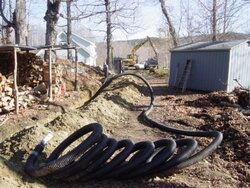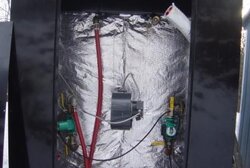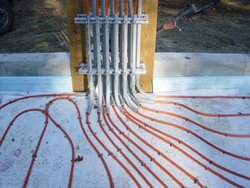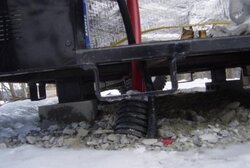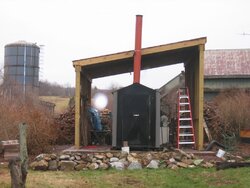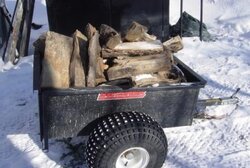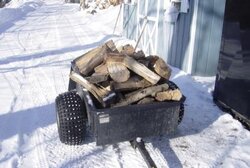I can't even begin to tell you what a project this has become. My idea of a fun project ended when the excavator could barely take this off the flatbed. This is a heavy, heavy machine due to all the fire brick. Anyways, I have lot's of pictures that I want to share and if anybody wants to know anything about this unit, just ask. I am measuring the fire wood I use and the unit is 150' from my house. The house is heated by typical baseboards. I am also in the process of hooking the system up to my barn that is 32' x 40'. It too is 150' away from the boiler. In the barn, I have a radiant slab that used 1 1/2" blue board, Farmtek's reflective bubble wrap and 3/4" Pex-Al-Pex. This should be quite the experiment since the barn is two story gambrel type and I have left the eaves open on the inside so the heat will rise and accumulate in the walls and under the upper floor. Some helpful hints for a successful install are to read the flipping directions. I saw another unit installed about 1/2 an hour from my house and they had the hoses/piping hooked up backwards. They had the feed (supply) going out of the top instead of the bottom, with the return going in the bottom, instead of the top. I did not use a plate exchanger, I went right into my existing oil boiler in the basement. I have the burner turned off and if I want to turn it on, I just hit the reset button on the injector. I tripped the 40 second safety relay (the eye) and they hooked it back up. It does like to eat wood when it's cold outside so, I am experimenting today with increasing the top-end from 180 F to 186 F. I am feeding it twice a day and did notice that when it was warmer, it didn't eat so much. We have nicknamed it the "monster" so we "feed the monster" (and check on the chickens too). Like I said, I've done this by myself and I'll be more than happy to answer any questions about it.
Sequoyah E3400 is finally installed!
- Thread starter AOTO
- Start date
-
Active since 1995, Hearth.com is THE place on the internet for free information and advice about wood stoves, pellet stoves and other energy saving equipment.
We strive to provide opinions, articles, discussions and history related to Hearth Products and in a more general sense, energy issues.
We promote the EFFICIENT, RESPONSIBLE, CLEAN and SAFE use of all fuels, whether renewable or fossil.
You are using an out of date browser. It may not display this or other websites correctly.
You should upgrade or use an alternative browser.
You should upgrade or use an alternative browser.
- Status
- Not open for further replies.
I
ISeeDeadBTUs
Guest
One thing for sure is keeping the darn thing level. What happened to me was the unit settled and got a little bit off kilter. It was leaning backwards. The creosote dripped into the fan/blower area and accumulated. It caught fire in there and almost fried my wiring. If the unit is level or even slightly tipped forward, this will not be a problem. I think because there is a tad bit of heat loss in the back with the pipes, that the ground in the front froze before the back did. Hence the lean.
shoeboxlen
Member
most of the OWB I have seen around here are installed on cement slabs. you may want to think about investing in one when the weather breaks. just a thought.
I actually picked up the back legs one at a time with my 4 ton floor jack and shimmed it forward. It's better now but not perfect. It is on cement blocks, on top of sure pack on top of gravel.The problem is picking the damn thing up!
Jim K in PA
Minister of Fire
Welcome to the Boiler Room. Congrats on your success.
Top feed vs bottom feed is often debated. GARN just changed their instructions to go from a draw off the bottom of the tank to the top. Water will be hotter at the top, of course.
Good luck with the unit.
Top feed vs bottom feed is often debated. GARN just changed their instructions to go from a draw off the bottom of the tank to the top. Water will be hotter at the top, of course.
Good luck with the unit.
hayrack
Member
In my opinion supply should come out of the top of your wood boiler and into the bottom of your oil. Your oil supply should come out of the top and return into the bottom of your wood. This works best if you are running your boilers in series to keep your oil boiler satisfied.
Eric Johnson
Mod Emeritus
My wood supply comes out of the top and goes into the top of the gas boiler (idle) in my basement. The return comes out of the bottom of the gas boiler and back into the bottom of the gasifier.
I don't know why you would put the supply from the wood into the return of the oil/gas, but a lot of people do it that way. The way I see it, the hottest water goes into the top of the gas boiler, from where it is immediately available to the zones. Faster response time and the hottest water is always going to the radiators.
I don't know why you would put the supply from the wood into the return of the oil/gas, but a lot of people do it that way. The way I see it, the hottest water goes into the top of the gas boiler, from where it is immediately available to the zones. Faster response time and the hottest water is always going to the radiators.
hayrack
Member
Because if it is going to the zones without going through the oil first the oil water temp will start to drop and the oil aquastat will kick the burner on. I had it plumbed your way for 7 yrs and I switched it last year and I have better results. Mine is in series yours is in parellel
Eric Johnson
Mod Emeritus
No, mine is in series as well. But I shut off the gas burner at the beginning of the heating season and don't turn it back on again until Spring. I also stuff insulation into the chimney to keep my wood-fired heat from going up the stack.
Thanks for the explanation. That makes sense.
Thanks for the explanation. That makes sense.
What I was referring to was the E3400 (OWB) supply and return, not the Oil fired boiler. Yes, in the basement of the house, the feed line goes in the top of the oil boiler and returns from the bottom, near the drain line. I am using the oil boiler simply as water storage and manifold. The E3400 is where the feed comes out for the bottom and the return goes in the top. Since the water is circulating all the time, it's easier for the water to be drawn out of the bottom (Gravity & pumped) and returned to the top where there is less head pressure.
Update -I just returned with the plumbing and electrical goodies to hook up my manifold in the barn for the radiant heat. I am hoping that Saturday afternoon, I will be up and warming. It was 9 F this morning.
Update -I just returned with the plumbing and electrical goodies to hook up my manifold in the barn for the radiant heat. I am hoping that Saturday afternoon, I will be up and warming. It was 9 F this morning.
Eric Johnson said:No, mine is in series as well. But I shut off the gas burner at the beginning of the heating season and don't turn it back on again until Spring. I also stuff insulation into the chimney to keep my wood-fired heat from going up the stack.
Thanks for the explanation. That makes sense.
Wow, I never thought about stuffing the chimney! That sounds like it makes a lot of sense. I have a power vent and I can feel cold air near the inside intake. When I stuck my hand in there, I did feel some warmth too, so I'm gonna cram something in there to stop that from leaking.
Eric Johnson
Mod Emeritus
Just be very careful about setting it up in such a way that you don't inadvertently turn on the oil burner while the chimney is blocked. Tape or otherwise lock the switch down with a tag attached reminding you (or whoever) to clear the chimney before turning the power back on. Kill the power to the boiler at the breaker box if you can, and tag it, too.
shoehorny
Member
[quote author="mhvfd" date="1231476420We have nicknamed it the "monster" so we "feed the monster".[/quote]
Hey MHVFD! Here's pictures of my "monster's" setup. This is my second year using it. It does deliver the heat but it goes through LOTS of wood! I basicaly had an easy time installing mine, but I did a lot of the work ahead of time and asked LOTS of questions before hand.
My monster sits on a patio of blocks that measure approximately 2'X2'X4". I have a compacted gravel bed beneath that. The patio is perfectly level. Since my monster sits on the edge of the patio, I have all the plumbing and electrical stuff coming up from under ground. I built the pavillion over it high enough to keep flames from licking the roof (for when the monster roars!) and it is wide enough to accomodate several cords of wood kept close at hand. Wind does blow in rain and snow from the open sides and I have not remedied that yet. I still have to add trim and paint it, then landscape the area. The monster sits about 100' feet from my house. It is used to heat about 3500sq feet of living space (we recently added a 25'X20' game room). We also use it to heat our hot water and hot tub.
My first year experience, so far, has been good. There have been some minor problems which customer service at Sequoyah took care of immediately. The two biggest problems, first, as you have already pointed out, involves creosote getting over everything! Second, wood consumption: I use about a 1/4 cord each day
I took a 4'X 4' pallet and bolted 4'X 2"X4" studs on two sides. Then I filled filled the area with firewood - jammed packed! (It took 8 wheelbarrels). Every 2 days I use up the entire stack of wood. The temperature has been about 30F average here in Central NJ. The wood I use is a good mix of mostly seasoned pine, sugar maple, and some cherry. Earlier this heating season, in October, I used far less wood and the monster would run for the whole day and night on one load (or approximately 2 wheelbarrels).
Anyway, I take LOTS of pictures! I've got pictures of about everything I do with this thing! I've also experimented with a lot of configurations involving heat exchangers and aquastats. I find the best setting is 180F shut off with 176F turn on for the aquastat. Inside at the oil burner, I have the aquastat (hydronic system) set at 125F for backup turn on, should I not get outside to load the wood. As for the heat exchanger, get at least a 32 plate one for a hydonic system. In this case, the bigger the better.
Good luck keeping warm!
Mike
Hey MHVFD! Here's pictures of my "monster's" setup. This is my second year using it. It does deliver the heat but it goes through LOTS of wood! I basicaly had an easy time installing mine, but I did a lot of the work ahead of time and asked LOTS of questions before hand.
My monster sits on a patio of blocks that measure approximately 2'X2'X4". I have a compacted gravel bed beneath that. The patio is perfectly level. Since my monster sits on the edge of the patio, I have all the plumbing and electrical stuff coming up from under ground. I built the pavillion over it high enough to keep flames from licking the roof (for when the monster roars!) and it is wide enough to accomodate several cords of wood kept close at hand. Wind does blow in rain and snow from the open sides and I have not remedied that yet. I still have to add trim and paint it, then landscape the area. The monster sits about 100' feet from my house. It is used to heat about 3500sq feet of living space (we recently added a 25'X20' game room). We also use it to heat our hot water and hot tub.
My first year experience, so far, has been good. There have been some minor problems which customer service at Sequoyah took care of immediately. The two biggest problems, first, as you have already pointed out, involves creosote getting over everything! Second, wood consumption: I use about a 1/4 cord each day

I took a 4'X 4' pallet and bolted 4'X 2"X4" studs on two sides. Then I filled filled the area with firewood - jammed packed! (It took 8 wheelbarrels). Every 2 days I use up the entire stack of wood. The temperature has been about 30F average here in Central NJ. The wood I use is a good mix of mostly seasoned pine, sugar maple, and some cherry. Earlier this heating season, in October, I used far less wood and the monster would run for the whole day and night on one load (or approximately 2 wheelbarrels).
Anyway, I take LOTS of pictures! I've got pictures of about everything I do with this thing! I've also experimented with a lot of configurations involving heat exchangers and aquastats. I find the best setting is 180F shut off with 176F turn on for the aquastat. Inside at the oil burner, I have the aquastat (hydronic system) set at 125F for backup turn on, should I not get outside to load the wood. As for the heat exchanger, get at least a 32 plate one for a hydonic system. In this case, the bigger the better.
Good luck keeping warm!
Mike
Attachments
Wow...I like the hinge on the back door. I'm going to do the same to mine, first chance I get. It has been very cold here, in fact last night it was -3 F. I think my consumption has increased since I ran a loop into my non-heated barn, I have another thread here on this site about using anti-freeze vs water for the initial fill. I have more pictures there. The loop into the barn just circulates back and is not hooked up into the radiant slab just yet so, I am wasting BTU's heating my Pex. (Silly me) Anyways, I feed it twice a day with a huge load in my little trailer and that usually will satisfy it. I am going thru more wood than I thought I would, but I think that next year after I make some insulated modifications, I should be fine. Part of my problem is that the wood I've used so far has been too small. I have bigger pieces coming up for February (as my stack goes from older wood to newer wood, which was cut much larger) so I should be able to get a real sense of consumption. It currently heats my house and soon, probably next year, the barn will be hooked up. I need to insulate my 1 1/4" supply/return lines and I need to dig up part of the underground work and insulate that better too. I included a picture of what mine is eating twice a day.
Attachments
- Status
- Not open for further replies.
Similar threads
- Replies
- 14
- Views
- 1K
- Replies
- 7
- Views
- 1K
- Replies
- 2
- Views
- 689
- Replies
- 12
- Views
- 3K


